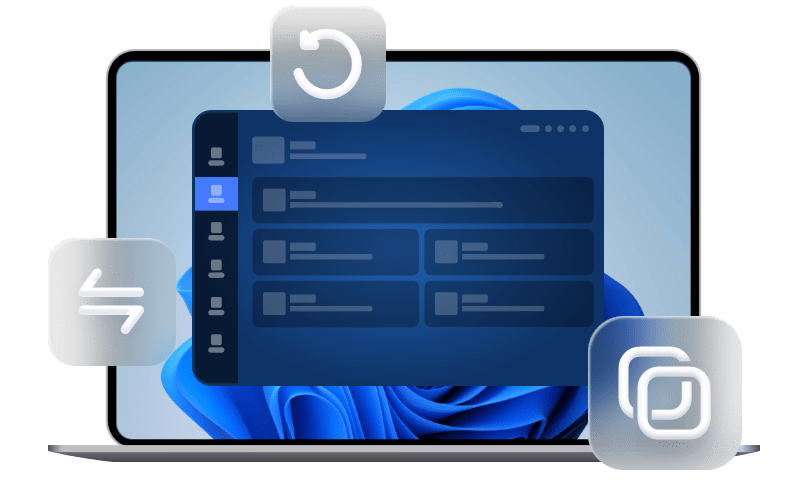How to Delete OS from Hard Drive - 2 Solutions
Whether you're deleting OS for upgrading, repurposing, or troubleshooting, you'll find everything you need to get the job done safely from this page.
Why remove OS from hard drive?
Removing an OS from a hard drive is useful when upgrading, troubleshooting, or reclaiming storage. Here are some common scenarios:
- Upgrading or Installing a New Operating System: If you’re switching from Windows to Linux, upgrading to a newer version of Windows, or performing a clean installation, you’ll need to remove the old OS first.
- Freeing Up Storage Space: Operating systems and their associated files can take up a large amount of disk space. If you have an old OS on a secondary drive that you no longer use, deleting it can free up space for other purposes.
- Fixing Boot Errors or Corrupt System Files: A corrupted OS can cause frequent crashes, boot failures, or system instability. Removing the OS and performing a fresh install can help resolve these issues.
Then, how to remove operating system from hard drive? Two solutions will be described below.
👉 Solution 1: Delete OS from hard drive using Diskpart
👉 Solution 2: Wipe OS from hard drive via third-party tool🔥
🔔 Important Note:
Before proceeding, ensure that you have backed up all important files from your hard drive. Deleting an OS will remove everything on that partition, and you won’t be able to recover files unless they’ve been backed up.
Solution 1: Delete OS from hard drive using Diskpart
If you try to delete OS partition in Disk Management, you’ll find the Delete Volume option greyed out. That’s because Windows won't allow you to delete a partition from which your computer is currently booting. To delete OS from hard drive successfully, you can boot your computer from Windows installation disk or recovery media and then run Diskpart commands. Follow the instructions below:
Step 1. Connect a Windows installation disk or recovery media to your computer. Restart your computer and change the boot order to boot from the USB/DVD.
Step 2. Once the installation or recovery environment loads, choose Repair your computer and then navigate to Troubleshoot > Advanced options > Command Prompt.
Step 3. In the Command Prompt window, type the following commands and press Enter after each.
- diskpart
- list disk
- select disk X (replace X with the number of the disk you want to delete the partition from)
- list partition
- select partition Y (replace Y with the number of the partition you want to delete)
- delete partition
Solution 2: Wipe OS from hard drive via third-party tool
If you need to completely remove operating system from hard drive, using a third-party tool like AOMEI Backupper Professional ensures a thorough and secure wipe. Unlike basic deletion methods, AOMEI Backupper provides disk wiping features that prevent data recovery, making it ideal for repurposing or selling a drive.

-
You can use it to wipe an entire disk or a specific partition, and even erase empty space on a hard drive.
-
It supports various storage devices, including HDDs, SSDs, USB flash drives, and memory cards.
-
You can perform the wipe within Windows or from a bootable USB.
Download AOMEI Backupper and follow these steps to wipe OS from hard drive:
Step 1. Install and run AOMEI Backupper. Click Tools > Disk Wipe.
Step 2. Choose the wiping type and the disk/partition to be wiped.
- To wipe only C drive, choose Wipe partition(s) or unallocated space on the disk and then select C drive.
- To wipe all partitions on the system disk, choose Wipe Disk and then select the disk containing OS.
Step 3. To delete OS, you will be prompted the operation needs to be executed in reboot mode. Click OK to confirm.
Step 4. Choose your desired wiping method and click Start. Please note that safer wiping methods come with more passes and lower wiping speeds.
- Fill sectors with Zero (Safe, Quick)
- Fill sectors with random data (Safe, Quick)
- DoD 5220.22-M (Very Safe, Slow)
- Gutmann (35 passes, Very Safe, Very Slow)
What happens after deleting the OS?
Removing an operating system (OS) from a hard drive has significant effects on your computer's functionality. See what happens next as follows:
1. The Computer Becomes Unbootable
Once the OS is deleted, the system loses the necessary files to start up. If you attempt to turn on the computer, you may encounter errors such as:
- "No bootable device found"
- "Operating system not found"
- "Insert boot media"
2. Data May Still Be Recoverable (Unless Securely Wiped)
Deleting an OS or formatting a drive doesn’t necessarily erase all data. In many cases, files can still be recovered using data recovery software unless the drive has been securely wiped using tools like AOMEI Backupper.
3. The Drive Becomes Unallocated Space
If you delete the OS partition, the storage space will appear as unallocated in Disk Management. You can:
✅ Create a new partition and use the drive for storage.
✅ Install a new OS if you plan to reuse the computer.
Conclusion
It’s a crucial step to delete OS from hard drive when upgrading, repurposing, or securely disposing of a system. Whether you use Diskpart or AOMEI Backupper, ensure to make a backup first to avoid irreversible data loss. You’ll be surprised to find that AOMEI Backupper also enables you to clone SSD to new SSD. Try it now to discover more!

